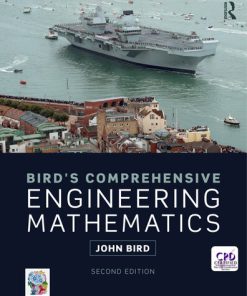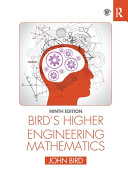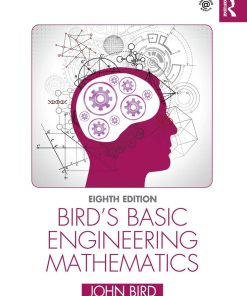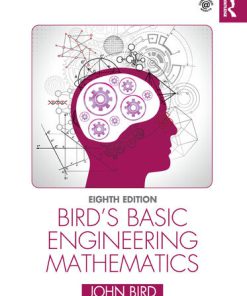Bird s Engineering Mathematics 9th Edition by John Bird ISBN 0367643782 9780367643782
$50.00 Original price was: $50.00.$25.00Current price is: $25.00.
Bird s Engineering Mathematics 9th Edition by John Bird – Ebook PDF Instant Download/Delivery: 0367643782, 9780367643782
Full download Bird s Engineering Mathematics 9th Edition after payment
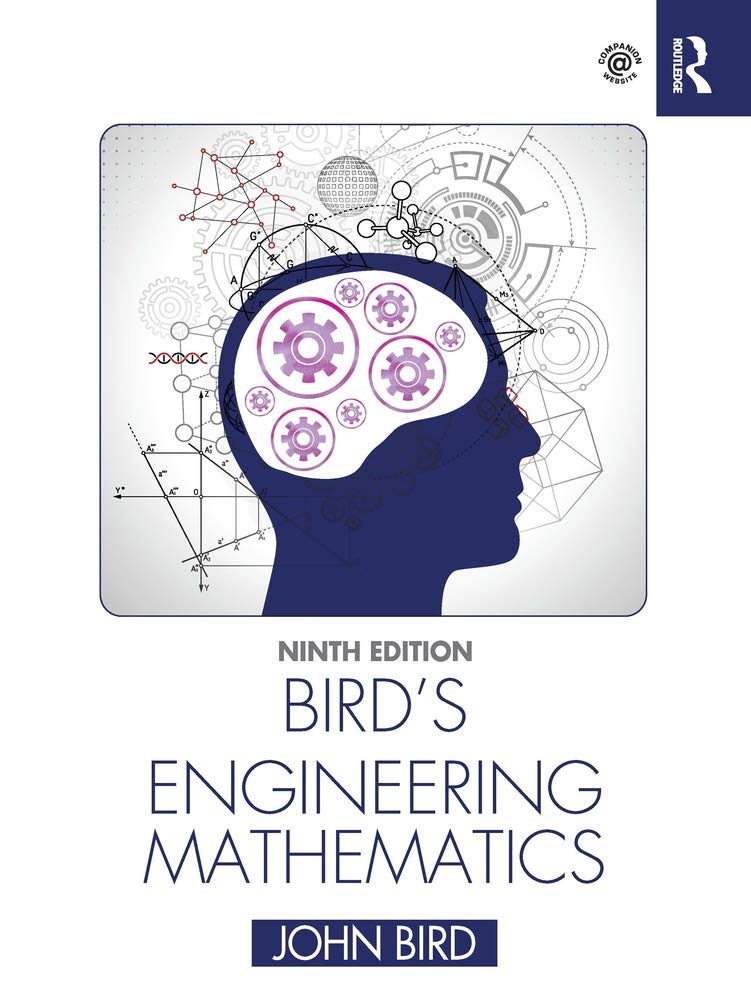
Product details:
ISBN 10: 0367643782
ISBN 13: 9780367643782
Author: John Bird
Bird s Engineering Mathematics 9th Edition Table of contents:
Section 1 Number and algebra
Chapter 1 Revision of fractions, decimals and percentages
1.1 Fractions
1.2 Ratio and proportion
1.3 Decimals
1.4 Percentages
Percentage absorption
Chapter 2 Indices, engineering notation and metric conversions
2.1 Indices
Reciprocal
Square root
Laws of indices
2.2 Standard form
2.3 Engineering notation and common prefixes
2.4 Metric conversions
Length in metric units
Areas in metric units
Volumes in metric units
2.5 Metric – US/imperial conversions
Temperature
Chapter 3 Binary, octal and hexadecimal numbers
3.1 Introduction
3.2 Binary numbers
3.3 Octal numbers
3.4 Hexadecimal numbers
Chapter 4 Calculations and evaluation of formulae
4.1 Errors and approximations
4.2 Use of calculator
4.3 Conversion tables and charts
4.4 Evaluation of formulae
Revision Test 1 Fractions, decimals, percentages, indices, numbering systems and calculations
Chapter 5 Algebra
5.1 Basic operations
5.2 Laws of indices
5.3 Brackets and factorisation
5.4 Fundamental laws and precedence
5.5 Direct and inverse proportionality
Chapter 6 Further algebra
6.1 Polynomial division
6.2 The factor theorem
6.3 The remainder theorem
Chapter 7 Partial fractions
7.1 Introduction to partial fractions
7.2 Partial fractions with linear factors
7.3 Partial fractions with repeated linear factors
7.4 Partial fractions with quadratic factors
Chapter 8 Solving simple equations
8.1 Expressions, equations and identities
8.2 Worked problems on simple equations
8.3 Further worked problems on simple equations
8.4 Practical problems involving simple equations
8.5 Further practical problems involving simple equations
Revision Test 2 Algebra, partial fractions and simple equations
Chapter 9 Transposition of formulae
9.1 Introduction to transposition of formulae
9.2 Worked problems on transposition of formulae
9.3 Further worked problems on transposition of formulae
9.4 Harder worked problems on transposition of formulae
Chapter 10 Solving simultaneous equations
10.1 Introduction to simultaneous equations
10.2 Worked problems on simultaneous equations in two unknowns
10.3 Further worked problems on simultaneous equations
10.4 More difficult worked problems on simultaneous equations
10.5 Practical problems involving simultaneous equations
Chapter 11 Solving quadratic equations
11.1 Introduction to quadratic equations
11.2 Solution of quadratic equations by factorisation
11.3 Solution of quadratic equations by ‘completing the square’
11.4 Solution of quadratic equations by formula
11.5 Practical problems involving quadratic equations
11.6 The solution of linear and quadratic equations simultaneously
Chapter 12 Inequalities
12.1. Introduction in inequalities
Some simple rules
12.2. Simple inequalities
12.3. Inequalities involving a modulus
12.4. Inequalities involving quotients
12.5. Inequalities involving square functions
12.6. Quadratic inequalities
Chapter 13 Logarithms
13.1. Introduction to logarithms
What is a logarithm?
Common logarithms
Napierian logarithms
13.2. Laws of logarithms
13.3. Indicial equations
13.4. Graphs of logarithmic functions
Revision Test 3 Simultaneous and quadratic equations, transposition of formulae, inequalities and logarithms
Chapter 14 Exponential functions
14.1 Introduction to exponential functions
14.2 The power series for ex
14.3 Graphs of exponential functions
14.4 Napierian logarithms
14.5 Laws of growth and decay
Chapter 15 Number sequences
15.1. Arithmetic progressions
15.2. Worked problems on arithmetic progressions
15.3. Further worked problems on arithmetic progressions
15.4. Geometric progressions
15.5. Worked problems on geometric progressions
15.6. Further worked problems on geometric progressions
15.7. Combinations and permutations
Chapter 16 The binomial series
16.1. Pascal’s triangle
16.2. The binomial series
16.3. Worked problems on the binomial series
16.4. Further worked problems on the binomial series
16.5. Practical problems involving the binomial theorem
Revision Test 4 Exponential functions, number sequences, and the binomial series
Section 2 Trigonometry
Chapter 17 Introduction to trigonometry
17.1 Trigonometry
17.2 The theorem of Pythagoras
17.3 Trigonometric ratios of acute angles
17.4 Fractional and surd forms of trigonometric ratios
17.5 Evaluating trigonometric ratios of any angles
17.6 Solution of right-angled triangles
17.7 Angle of elevation and depression
17.8 Trigonometric approximations for small angles
Chapter 18 Trigonometric waveforms
18.1. Graphs of trigonometric functions
18.2. Angles of any magnitude
18.3. The production of a sine and cosine wave
18.4. Sine and cosine curves
Graphs of sine and cosine waveforms
Periodic functions and period
Amplitude
Lagging and leading angles
18.5. Sinusoidal form A sin (ωt ± α)
18.6. Waveform harmonics
Chapter 19 Cartesian and polar co-ordinates
19.1. Introduction
19.2. Changing from Cartesian into polar co-ordinates
19.3. Changing from polar into Cartesian co-ordinates
19.4. Use of Pol/Rec functions on calculators
Revision Test 5 Trigonometry
Chapter 20 Triangles and some practical applications
20.1 Sine and cosine rules
Sine rule
Cosine rule
20.2 Area of any triangle
20.3 Worked problems on the solution of triangles and their areas
20.4 Further worked problems on the solution of triangles and their areas
20.5 Practical situations involving trigonometry
20.6 Further practical situations involving trigonometry
Chapter 21 Trigonometric identities and equations
21.1 Trigonometric identities
21.2 Worked problems on trigonometric identities
21.3 Trigonometric equations
21.4 Worked problems (i) on trigonometric equations
21.5 Worked problems (ii) on trigonometric equations
21.6 Worked problems (iii) on trigonometric equations
21.7 Worked problems (iv) on trigonometric equations
Chapter 22 Compound angles
22.1 Compound angle formulae
22.2 Conversion of a sinωt + b cosωt into R sin(ωt +α)
22.3 Double angles
22.4 Changing products of sines and cosines into sums or differences
22.5 Changing sums or differences of sines and cosines into products
Revision Test 6 Further trigonometry
Section 3 Areas and volumes
Chapter 23 Areas of common shapes
23.1 Introduction
23.2 Properties of quadrilaterals
Polygon
23.3 Areas of common shapes
23.4 Worked problems on areas of common shapes
23.5 Further worked problems on areas of plane figures
23.6 Worked problems on areas of composite figures
23.7 Areas of similar shapes
Chapter 24 The circle and its properties
24.1. Introduction
24.2. Properties of circles
24.3. Radians and degrees
24.4. Arc length and area of circles and sectors
Arc length
Area of circle
Area of sector
24.5. Worked problems on arc length and area of circles and sectors
24.6. The equation of a circle
Chapter 25 Volumes and surface areas of common solids
25.1. Introduction
25.2. Volumes and surface areas of regular solids
25.3. Worked problems on volumes and surface areas of regular solids
25.4 Further worked problems on volumes and surface areas of regular solids
25.5 Volumes and surface areas of frusta of pyramids and cones
Method 1
Method 2
Method 1
Method 2
25.6 The frustum and zone of a sphere
25.7 Prismodal rule
25.8 Volumes of similar shapes
Chapter 26 Irregular areas and volumes and mean values of waveforms
26.1 Area of irregular figures
26.2 Volumes of irregular solids
26.3 The mean or average value of a waveform
Revision Test 7 Areas and volumes
Section 4 Graphs
Chapter 27 Straight line graphs
27.1 Introduction to graphs
27.2 The straight line graph
27.3 Practical problems involving straight line graphs
Chapter 28 Reduction of non-linear laws to linear form
28.1 Determination of law
28.2 Determination of law involving logarithms
Chapter 29 Graphs with logarithmic scales
29.1 Logarithmic scales
29.2 Graphs of the form y = ax n
29.3 Graphs of the form y=ab x
29.4 Graphs of the form y =ae k x
Chapter 30 Graphical solution of equations
30.1 Graphical solution of simultaneous equations
30.2 Graphical solution of quadratic equations
30.3 Graphical solution of linear and quadratic equations simultaneously
30.4 Graphical solution of cubic equations
Chapter 31 Functions and their curves
31.1 Standard curves
31.2 Simple transformations
31.3 Periodic functions
31.4 Continuous and discontinuous functions
31.5 Even and odd functions
Even functions
Odd functions
31.6 Inverse functions
Inverse trigonometric functions
Revision Test 8 Graphs
Section 5 Graphs
Chapter 32 Complex numbers
32.1 Cartesian complex numbers
32.2 The Argand diagram
32.3 Addition and subtraction of complex numbers
32.4 Multiplication and division of complex numbers
32.5 Complex equations
32.6 The polar form of a complex number
Calculator
32.7 Multiplication and division in polar form
32.8 Applications of complex numbers
Chapter 33 De Moivre’s theorem
33.1 Introduction
33.2 Powers of complex numbers
33.3 Roots of complex numbers
Section 6 Vectors
Chapter 34 Vectors
34.1 Introduction
34.2 Scalars and vectors
34.3 Drawing a vector
Representing a vector
34.4 Addition of vectors by drawing
(a) Nose-to-tail method
(b) Parallelogram method
(a) ‘Nose-to tail’ method
(b) ‘Parallelogram’ method
34.5 Resolving vectors into horizontal and vertical components
34.6 Addition of vectors by calculation
34.7 Vector subtraction
34.8 Relative velocity
34.9 i, j and k notation
Chapter 35 Methods of adding alternating waveforms
35.1 Combination of two periodic functions
35.2 Plotting periodic functions
35.3 Determining resultant phasors by drawing
35.4 Determining resultant phasors by the sine and cosine rules
35.5 Determining resultant phasors by horizontal and vertical components
35.6 Determining resultant phasors by complex numbers
Revision Test 9 Complex numbers and vectors
Section 7 Differential calculus
Chapter 36 Introduction to differentiation
36.1. Introduction to calculus
36.2. Functional notation
36.3. The gradient of a curve
36.4. Differentiation from first principles
36.5. Differentiation of y = ax n by the general rule
36.6. Differentiation of sine and cosine functions
36.7. Differentiation of e ax and ln ax
Chapter 37 Methods of differentiation
37.1. Differentiation of common functions
37.2. Differentiation of a product
37.3. Differentiation of a quotient
37.4. Function of a function
37.5. Successive differentiation
Chapter 38 Some applications of differentiation
38.1. Rates of change
38.2. Velocity and acceleration
38.3. Turning points
38.4. Practical problems involving maximum and minimum values
38.5. Points of inflexion
38.6. Tangents and normals
Tangents
Normals
38.7. Small changes
Chapter 39 Solving equations by Newton’s method
39.1 Introduction to iterative methods
39.2 The Newton–Raphson method
39.3 Worked problems on the Newton–Raphson method
Chapter 40 Maclaurin’s series
40.1 Introduction
40.2 Derivation of Maclaurin’s theorem
40.3 Conditions of Maclaurin’s series
40.4 Worked problems on Maclaurin’s series
Revision Test 10 Differentiation
Chapter 41 Differentiation of parametric equations
41.1 Introduction to parametric equations
41.2 Some common parametric equations
41.3 Differentiation in parameters
41.4 Further worked problems on differentiation of parametric equations
Chapter 42 Differentiation of implicit functions
42.1 Implicit functions
42.2 Differentiating implicit functions
42.3 Differentiating implicit functions containing products and quotients
42.4 Further implicit differentiation
Chapter 43 Logarithmic differentiation
43.1 Introduction to logarithmic differentiation
43.2 Laws of logarithms
43.3 Differentiation of logarithmic functions
43.4 Differentiation of further logarithmic functions
43.5 Differentiation of [ f(x)] x
Revision Test 11 Further differentiation
Section 8 Integral calculus
Chapter 44 Standard integration
44.1 The process of integration
44.2 The general solution of integrals of the form ax n
44.3 Standard integrals
44.4 Definite integrals
Chapter 45 Integration using algebraic substitutions
45.1 Introduction
45.2 Algebraic substitutions
45.3 Worked problems on integration using algebraic substitutions
45.4 Further worked problems on integration using algebraic substitutions
45.5 Change of limits
Chapter 46 Integration using trigonometric substitutions
46.1 Introduction
46.2 Worked problems on integration of sin2 x, cos2 x, tan2 x and cot2 x
46.3 Worked problems on integration of powers of sines and cosines
46.4 Worked problems on integration of products of sines and cosines
Worked problems on integration using the sin θ substitution
Worked problems on integration using the tan θsubstitution
Revision Test 12 Integration
Chapter 47 Integration using partial fractions
47.1 Introduction
47.2 Integration using partial fractions with linear factors
47.3 Integration using partial fractions with repeated linear factors
47.4 Integration using partial fractions with quadratic factors
Chapter 48 The t=tanθ2 substitution
48.1 Introduction
48.2 Worked problems on the t=tanθ2 substitution
48.3 Further worked problems on the t=tanθ2 substitution
Chapter 49 Integration by parts
49.1 Introduction
49.2 Worked problems on integration by parts
49.3 Further worked problems on integration by parts
Chapter 50 Numerical integration
50.1 Introduction
50.2 The trapezoidal rule
50.3 The mid-ordinate rule
50.4 Simpson’s rule
50.5 Accuracy of numerical integration
Revision Test 13 Further integration
Chapter 51 Areas under and between curves
51.1 Area under a curve
51.2 Worked problems on the area under a curve
51.3 Further worked problems on the area under a curve
51.4 The area between curves
Chapter 52 Mean and root mean square values
52.1 Mean or average values
52.2 Root mean square values
Chapter 53 Volumes of solids of revolution
53.1 Introduction
53.2 Worked problems on volumes of solids of revolution
53.3 Further worked problems on volumes of solids of revolution
Chapter 54: Centroids of simple shapes
54.1. Centroids
54.2. The first moment of area
54.3. Centroid of area between a curve and the x-axis
54.4 Centroid of area between a curve and the y-axis
54.5. Worked problems on centroids of simple shapes
54.6. Further worked problems on centroids of simple shapes
54.7. Theorem of Pappus
Chapter 55 Second moments of area
55.1 Second moments of area and radius of gyration
Radius of gyration
55.2 Second moment of area of regular sections
55.3 Parallel axis theorem
55.4 Perpendicular axis theorem
55.5 Summary of derived results
55.6 Worked problems on second moments of area of regular sections
55.7 Worked problems on second moments of area of composite areas
Revision Test 14 Boolean algebra, logic circuits, matrices and determinants
Section 9 Differential equations
Chapter 56 Introduction to differential equations
56.1 Family of curves
56.2 Differential equations
56.3 The solution of equations of the form dydx = f (x)
56.4 The solution of equations of the form d yd x = f (y)
56.5 The solution of equations of the form dydx = f (x) · f (y)
Revision Test 15 Differential equations
Section 10 Further number and algebra
Chapter 57 Boolean algebra and logic circuits
57.1 Boolean algebra and switching circuits
The or-function
The and-function
The not-function
57.2 Simplifying Boolean expressions
57.3 Laws and rules of Boolean algebra
57.4 De Morgan’s laws
57.5 Karnaugh maps
(i) Two-variable Karnaugh maps
(ii) Three-variable Karnaugh maps
(iii) Four-variable Karnaugh maps
57.6 Logic circuits
The and-gate
The or-gate
The invert-gate or not-gate
The nand-gate
The nor-gate
Combinational logic networks
57.7 Universal logic gates
Chapter 58 The theory of matrices and determinants
58.1 Matrix notation
58.2 Addition, subtraction and multiplication of matrices
58.3 The unit matrix
58.4 The determinant of a 2 by 2 matrix
58.5 The inverse or reciprocal of a 2 by 2 matrix
58.6 The determinant of a 3 by 3 matrix
58.7 The inverse or reciprocal of a 3 by 3 matrix
Chapter 59 The solution of simultaneous equations by matrices and determinants
59.1 Solution of simultaneous equations by matrices
59.2 Solution of simultaneous equations by determinants
59.3 Solution of simultaneous equations using Cramer’s rule
59.4 Solution of simultaneous equations using the Gaussian elimination method
Revision Test 16 Boolean algebra, logic circuits, matrices and determinants
Section 11 Statistics
Chapter 60 Presentation of statistical data
60.1 Some statistical terminology
60.2 Presentation of ungrouped data
60.3 Presentation of grouped data
Chapter 61 Mean, median, mode and standard deviation
61.1. Measures of central tendency
61.2. Mean, median and mode for discrete data
Mean
Median
Mode
61.3. Mean, median and mode for grouped data
Histogram
61.4. Standard deviation
(a) Discrete data
(b) Grouped data
61.5. Quartiles, deciles and percentiles
Chapter 62 Probability
62.1. Introduction to probability
Expectation
Dependent event
Independent event
Conditional probability
62.2 Laws of probability
The addition law of probability
The multiplication law of probability
62.3. Worked problems on probability
62.4. Further worked problems on probability
(a) With replacement
(b) Without replacement
62.5. Permutations and combinations
Permutations
Combinations
62.6. Bayes’ theorem
Revision Test 17 Presentation of statistical data, mean, median, mode, standard deviation and probability
Chapter 63 The binomial and Poisson distribution
63.1. The binomial distribution
Industrial inspection
Histogram of probabilities
63.2. The Poisson distribution
Histogram of probabilities
Chapter 64 The normal distribution
64.1. Introduction to the normal distribution
64.2. Testing for a normal distribution
Revision Test 18 The binomial, Poisson and normal distributions
Chapter 65 Linear correlation
65.1. Introduction to linear correlation
65.2. The Pearson product-moment formula for determining the linear correlation coefficient
65.3. The significance of a coefficient of correlation
65.4. Worked problems on linear correlation
Chapter 66 Linear regression
66.1. Introduction to linear regression
66.2. The least-squares regression lines
66.3. Worked problems on linear regression
Chapter 67 Sampling and estimation theories
67.1 Introduction
67.2 Sampling distributions
67.3 The sampling distribution of the means
67.4 The estimation of population parameters based on a large sample size
Point and interval estimates
Confidence intervals
67.5 Estimating the mean of a population based on a small sample size
Revision Test 19 Presentation of statistical data, mean, median, mode, standard deviation and probability
List of essential formulae
Number and algebra
Length in metric units:
Areas in metric units:
Volumes in metric units:
Laws of indices:
Factor theorem
Remainder theorem
Partial fractions
Quadratic formula:
Definition of a logarithm:
Laws of logarithms:
Exponential series:
Arithmetic progression:
Geometric progression:
Binomial series:
Newton Raphson iterative method
Trigonometry
Theorem of Pythagoras:
Identities:
Triangle formulae:
Compound angle formulae
Double angles
Products of sines and cosines into sums or differences:
Sums or differences of sines and cosines into products:
Cartesian and polar co-ordinates
Areas and volumes
Areas of plane figures:
Volumes and surface areas of regular solids:
Irregular areas
Trapezoidal rule
Mid-ordinate rule
Volume of irregular solids
For a sine wave:
Graphs
Equations of functions
Odd and even functions
Complex numbers
Differential calculus
Standard derivatives
Function of a function:
Parametric differentiation
Implicit function:
Maximum and minimum values:
Points of inflexion
Tangents and normals
Maclaurin’s series
Integral calculus
Standard integrals
Numerical integration
Trapezoidal rule
Second moment of area and radius of gyration
Area under a curve:
Differential equations
First order differential equations
Further number and algebra
Boolean algebra
Matrices:
Statistics and probability
Mean, median, mode and standard deviation
Bayes’ theorem
Binomial probability distribution
Poisson distribution
Product-moment formula for the linear correlation coefficient:
Symbols:
Standard error of the means
The relationship between sample mean and population mean
Estimating the mean of a population (σ known)
Estimating the mean of a population (σ unknown)
Estimating the standard deviation of a population
Estimating the mean of a population based on a small sample size
Answers Answers to Practice Exercises
People also search for Bird s Engineering Mathematics 9th Edition:
bird engineering
bird engineering maths
t-bird engineering lafayette
engineering mathematics v
engineering mathematics j. bird
Tags: John Bird, Bird s Engineering, Mathematics
You may also like…
Engineering - Mechanical Engineering & Dynamics
Engineering - Engineering - General & Miscellaneous
Mathematics - Applied Mathematics
Bird s Higher Engineering Mathematics 9th Edition J. O. Bird
Engineering - Electrical & Electronic Engineering
Bird’s Electrical Circuit Theory and Technology, 7th Edition John O. Bird
Engineering - Engineering - General & Miscellaneous
Engineering - Engineering - General & Miscellaneous
Bird s Higher Engineering Mathematics 9th Edition by John Bird 9781000353037 1000353036




